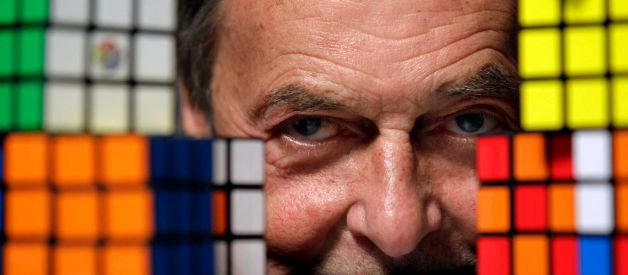
Ernő Rubik © Julio Cortez
On June 2, 1980, the world’s most famous puzzle – Rubik’s Cube – started to spread all over the world, infecting the population with addiction and curiosity about its solving.
The Rubik’s Cube Craze
The Rubik’s Cube started to take over Germany in 1980, but its birth lays back in Hungary in the mid 1970’s. The magic cube is named after its creator Ernő Rubik, who is a Hungarian architect and inventor. Between 1971 and 1975 he worked as a professor at the Budapest College of Applied Arts in the department of interior design and during these years, the magic cube was born. Ernő Rubik invented the cube to show his classes how 3D objects move and to teach structural design problems like “How could the blocks move independently without falling apart?” Back then he didn’t realize he had just created the best selling puzzle game in history. The first time he twisted the cube for a few times he began noticing, that it is even harder to twist the blocks back in order and it took him a whole month to figure out a right solution.
Entering the Capitalist World
After Rubik was granted Hungarian Patent No. 170062 for the Cube on 28 October 1976, the Cube entered the “capitalist world” in December 1977 when a copy of the Cube was sent to the British company Pentangle. This company then acquired the licence to distribute the cube in Great Britain. In 1979, however, the Hungarian government granted the worldwide sales rights for the cube to the US company Ideal Toy Corporation (also known in Europe as Arxon). This also included the rights for the United Kingdom in breach of the Treaty. Ideal Toy Corporation allowed Pentangle to sell the cube to gift shops, but not to toy stores.
The 1981 Popularity Peak
In 1981, the demand for mechanical patience play reached its peak. Ideal Toy Corporation was unable to meet demand, allowing cheap Far Eastern products to flood the market. Altogether, about 160 million cubes were sold until the peak of the boom. In early 1982 the demand for the dice collapsed and with it the demand for many other puzzles.
But not the First…
Ernő Rubik was not the first to deal with the theme of a game of this kind. As early as 1957, the chemist Larry Nichols developed a similar cube, which, however, consisted of only 2×2×2 parts and was held together by magnets. He had his design patented in 1972. In 1984 Nichols won a patent lawsuit against the company that sold the Rubik’s Cube in the USA. However, this judgment was partially annulled in 1986, so that it only concerned the 2×2×2 Pocket Cube.
Speedcubing
Nowadays many algorithms are widely spread all over the Web. After the big hype in the 1980’s the magical cube was gone for a while, but in the past years it came back to households and even classrooms. Now the focus lies not on solving the cube, but rather on speedcubing. Speedcuber can solve any twisted Rubik’s Cube with 45 to 60 movements. Speedcubing depends on the quick recognition of positions, the internalization of a high number of algorithms, planning ahead and dexterity. In Speedcubing national, continental and world championships are held by the World Cube Association (WCA).
The World Championship
The first World Championship, organized by the Guinness Book of Records, took place in Munich on March 13, 1981. The cubes were twisted 40 times and rubbed with vaseline. Winner of the championship was Jury Fröschl from Munich with a record time of 38 seconds. The current world record for a 3×3×3 cube is 4.22 seconds and was set by Feliks Zemdegs at Cube for Cambodia 2018.
Other challenges these days include the blind-folded solving, underwater solving, and solving the cube with the feet. Also, many variations of the original cube were created, for example the V-Cube 7 or the Pocket Cube.
Group theory 101: How to play a Rubik’s Cube like a piano – Michael Staff, [6]
References and Further Reading:
- [1] Adventures in Group Theory: Rubik’s Cube, Merlin’s Machine, and Other Mathematical Toys
, Published by Johns Hopkins University Press, 2008
- [2] Rubik’s Cube History
- [3] Rubik’s Cube at Britannica
- [4] Rubik’s Cube at Wikidata
- [5] Safecracker Method: Solving Rubik’s Cube with just 10 Numbers
- [6] Group theory 101: How to play a Rubik’s Cube like a piano – Michael Staff, TED-Ed @ youtube
- [7] Villapaz, Luke.“Rubik’s Cube 40th Anniversary: 9 Facts Behind The Famous 3-D Toy Puzzle”.International Business Times, 25 April 2014.
- [8] Timeline of Logic Puzzles, via DBpedia and Wikidata





